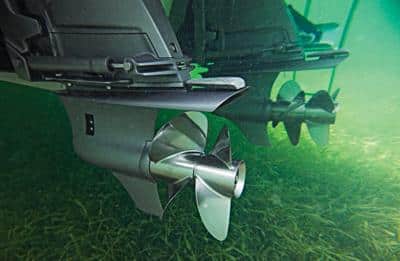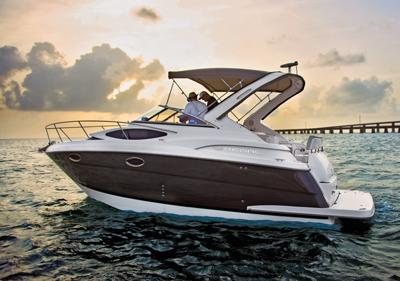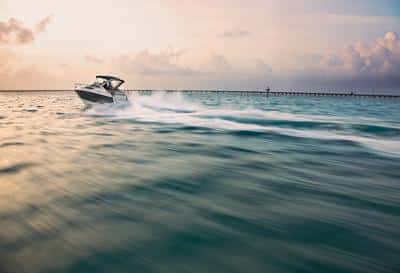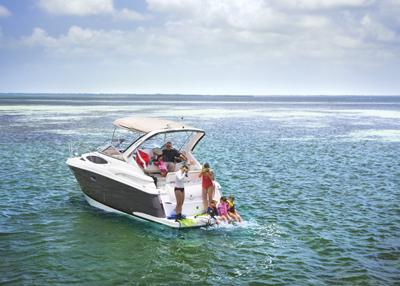According to our dash-mounted GPS, it is about 13 nautical miles from Bahia Honda Marina to Big Spanish Key — yes, one of those Keys, in the southernmost reaches of Florida and framed by water colors that Crayola cannot imitate. We’re ahead of schedule, idling out of the harbor at 6:50 a.m., lunch neatly stowed in the galley of the Regal 2860 and snorkel gear secure in the transom locker. The crew in the cabin adds an unexpected tranquility at this hour: Four kids and two moms are silently peering through the cabin’s portholes, mesmerized by the reflection of morning clouds on the water. It is seriously quiet. Already it’s the kind of day that the Florida Keys Tourism Council promises. It calls this “boater’s paradise.” Of course, every coastal region in the United States has kicked that term around so much that, like a Hacky Sack, it lost its clout years ago. Here in the Keys, though, it still plays well. Simple numbers bear this out:
• The Keys draw 4 million visitors a year, and they come not for conventions or casinos (there are none) but to be on the water, which is why there are 36 boat-rental shops.
• The nautical playground encompasses 2,900 square miles of Atlantic and Gulf waters, and once on it, there are 6,000 reefs and 800 islands to explore.
• It’s so boater-centric that those islands are called keys (derived from the Spanish word cayo, for little island), with names that magnify the come-as-you-are nature of the area: Happy Jack, Bowlegs and Knockemdown. You cannot help but wear a big floppy hat on your head and a silly look of freedom on your face.
But then, just outside Bahia Honda’s harbor, with our ridiculously baggy shirts starting to billow, we encounter our first source of angst. There, directly in the narrow channel under one of the Keys’ 42 bridges, is a dive buoy and flag.
“With as many boaters as we have, some are bound to do unbelievable things,” Billy Causey, former superintendent of the Florida Keys National Marine Sanctuary, had warned me earlier. His was one of six preparatory confabs I’d had with local experts before this trip.
The dive buoy smack-dab in the channel forces us to choose one of two actions: buzz right past the flag and murmur unpleasantries about the windbag who put it there, just as two other irritated boaters are doing, or prudently find an alternate course at least 300 feet from the flag.
“The depth is five feet under this other bridge section,” says my co-captain and 20-year Keys boating veteran, Chris. He’s fingering a paper chart that has our preplanned course — now moot — highlighted in yellow.
We take the secondary route, away from the divers and on plane so as not to test the draft of the 2860, which, with our load of people, gear and fuel, is closer to 38 inches than the 36 inches listed on the specs. While taking the bypass, we make sure the numbers on our depth sounder match those on the chart, especially when we’re forced to thread a needlelike strip of six feet of depth that leads back into the channel on the other side of the bridge. All is still serene belowdecks, but up top our eyes are as wide and white as coffee-cup lids.

“You have to be more alert here,” Causey said. Numbers support the boater’s paradise theory, perhaps. But another series of numbers spell “boater beware”:
• Monroe County, which essentially is the Keys, had more reported boating accidents in 2008 than did 47 states.
• There are as many boats unregistered in the county as registered — i.e., visitors unfamiliar with the water.
• Remember the 6,000 reefs and 800 keys? That means the depth changes quickly and rarely hits double digits, and the bottom is hardly Cottonelle soft.
“It’s easy to see all this beautiful water, jump in the boat and think, ‘let’s go!’” said Florida Fish and Wildlife officer Bobby Dube. “But you have to know how to use your chart and read the surroundings. We train our officers to navigate without electronics in case they go black. Read the shadows, tree branches, anything. The water colors tell you a lot.”
The old mariner refrain should be plastered on every marker in the Keys: “Brown, brown, run aground. White, white, and you might. Green, green, nice and clean. Blue, blue, sail on through.” It is currently ringing in my head, over and over and over.
Finally clear of the divers, we embark on a side trip to the world famous Seven-Mile Bridge. The channel is slightly wider than a tightrope near Marker 36, with white (“ … and you might”) showing on either side. Most disconcerting is Marker 37. it’s there on the chart, but our four giant eyeballs can’t find it on the water. Instead, we use a compass bearing of 78 degrees, which on the GPS looks to keep us in six to eight feet, and take a leap of faith toward Marker 38.
In doing so, I can’t help but think of what happened near Islamorada three days earlier, when a trawler captain missed a marker, found shallow water and grounded. He enjoyed the landing so much that he kept going for 1,000 yards until his hull stuck hard, like a pit in an avocado. Not only did he suffer major damage to his boat and the indignity of calling for a tow off the protected sea grass, but he was also looking at a fine of $100,000 for splitting the sanctuary floor.
“You can’t just haul off and go across the middle of bays,” Vic Spellberg, director of sponsor promotions for Formula Boats, warned me. “My charts have these highlighted U-turns and jagged lines. The next marker isn’t necessarily the one you see directly ahead. It can be 45 degrees to either side. Cutting corners is the fastest way to the prop shop, or worse.”
This is why Maya Meyer, owner of Big pine Key Boat rentals, carries 30 spare props for her fleet of 11 boats. Last summer her mechanic changed one boat’s prop four times in a week.
“My first advice is, if you don’t know an area, don’t go there,” Meyer said. “It isn’t worth the risk.”

The sun is just clearing the clouds on the horizon, producing a dramatic backlit view of the Seven-Mile Bridge. From here to there appears to be open cruising. But on the GPS is a tiny circle with the word Boiler, and we’re on a collision course with it. A three-degree correction takes us around what is basically an underwater atoll, one that might have devastated our hull.
“The number of groundings has gone down over the years because of navaids,” said Bruce Popham, owner of Marathon Boat Yard. While he told me this on a Monday, all nine of his techs were busy, some working on major bottom repairs. One boat, a catamaran, sank three days earlier. “I still hear all the excuses about the markers or the seafloor moving. That’s ridiculous. Nine times out of 10 it’s driver error. You have to use a chart and GPS to cross-reference. We still have a few hundred groundings a year, but it used to be way more.”
The marine sanctuary was established shortly after three ships grounded in a 17-day period in the fall of 1989. At that time there was also an average of nearly two small-boat groundings per day.
“There’s a lot of water out here, and it can’t all be marked,” Popham said. “You might only see a marker every couple of miles. It should compel boaters to stay within a navigable area on the chart.”
We pull into neutral at the base of the Seven-Mile Bridge, one of the most photographed landmarks in South Florida. On one side is the Atlantic, on the other the Gulf of Mexico. We settle on the Gulf side because the wind and waves are coming from the ocean side, and it seems safer to let them gradually push our boat farther into open Gulf water. It’s the wrong call. After half a minute we realize that the tide is shoving us the opposite way, toward the ocean … and the bridge pilings between it and us.
“You have to watch what the tide’s doing with your eyes,” Capt. Chris Brown of Stray Cat Charters told me. “Your chart could say high tide, but on the bayside it might be rising for another two hours. It’s easy to get caught in a current because the tide hasn’t completed its cycle on both sides.”
As we fire up the Volvos and start cruising toward Big Spanish Key, we make a move around a “Danger Shoal” marker … and notice we’re in four feet of water. I stay on plane until the water turns dark blue, then stop and gaze back in wonder, as would a person who had just stepped in dog manure: “Where did that come from?”

The paper chart doesn’t show the shoal or the marker, and in fact had us in five to seven feet back there. And then there’s the GPS. It actually shows two hazard markers, 30 feet apart and with blue water in between. Here’s the reality: The “Danger” marker sits over a three-foot shallow, and nearby is an unmarked underwater hump the size of a whale. Had this been low tide, we would have felt it.
“Use everything you have,” Brown said. “If something doesn’t add up, stop and figure it out. Never be in a hurry when you’re boating here.”
The course to Big Spanish is mottled on the chart with telltale abbreviations like rky, obstn and subm pile. My eyes catch a thin finger of brown jutting into our otherwise blue straightaway. Another boiler bubbles up on the chart. We even curl around a sizable hub marked as a Key Deer refuge. Key deer refuge! It’s in open water!
Using the compass, chart, water color and GPS, we run around the obstacle course. By mid-morning the water, ensconced in the Keys and their obstructions, has turned glassy. On the surface this would seem to bring with it a limplegged calm at the helm, but Brown had warned me about this.
“The hardest navigating is when there’s no whisper of wind,” he said. “You can’t read the water when it’s mirror flat.”
We’re also locating markers two miles apart and some at hard angles, as Spellberg had cautioned. So, boat traffic becomes a fifth source in our navigation toolbox. We keep an eye on three big sportfishers running a conga line well ahead of us. If they hit ground we’ll know it.
Following a sharp starboard turn, and an equally abrupt turn to port, we find a seafloor ahead so white that it’s visible through the surface glare. This will be our snorkeling turf. We approach slowly, watching the depth to avoid kissing the prop on the grass, before walking the anchor out and nesting it by hand on the soft bottom. Not everyone is so careful.

“Of the sinkings reported to us, 90 percent are because of anchoring off the stern,” Dube told me. “We rescued a guy last week who did that. His boat started taking on water so he went to the stern to check it out — worst thing you can do because his weight overwhelmed the bilge. When we found the guy, he was sitting on a portable fuel tank, smoking a cigarette.”
The tide pulls the slack out of our anchor line, and the Regal settles neatly into place. Snorkel gear is pulled from the transom locker. It has taken three hours to travel 13 miles, plus the extra six miles to the bridge for photos. But this is a boater’s paradise. You don’t care about the wayward gob of sunscreen on your ear. You wear hats that you don’t wear at home. and you never, ever hurry to get from here to there.
Anatomy of an Accident
Monroe County, which encompasses most of the Florida Keys, has the dubious distinction of leading the state in boating accidents year after year. In fact, its reported accidents in 2008 (657) outpaced those of 47 states. The county and state law enforcement reports show the following as the most common denominators of a boat crash.
• Male Operator (87 percent)
• While Cruising (86 percent)
• Operator with More than 100 Hours’ Experience (48 percent)
• Open Motorboat (35 percent)
• 36 to 50 Years Old (31 percent)
• In a Bay or Sound (22 percent)
• Between 2 p.m. and 6 p.m. (21 percent)
• Operator Inattention (20 percent)
• Month of May (15 percent)
3 Cardinal Rules
You won’t find these in the official Rules of the Road, but they should be branded on the brains of every boater on any water.
[1] Do Your Homework – Don’t wait to look at your chart (you do have one, right?) while you’re plying new water. Highlight your course in advance. Circle hazards that look like they might be easy to miss. Plan distances and fuel burn. The more you can anticipate beforehand, the less you’ll stress when in motion. Update your chart by using the Local Notices to Mariners, updated weekly and available at navcen.uscg.gov.
[2] Give Yourself Another 50 Percent – When it looks like a three-hour run, give yourself 4½ hours. Adding in an extra 50 percent of time sounds like a lot, until you get held up at the locks or you have to unclog the bilge or the no-wake zone goes on and on. Things happen. Boaters should never be in a position where they have to push the clock.
[3] It’s Smart to Stop – If you don’t know the water or the marker, you need to be in neutral. Ego only gets boaters into trouble. Stop. Study the chart again. If you still aren’t sure, go back to familiar water. And never get stuck navigating new or challenging water at night. That’s asking for trouble.
Have some boating safety tips to share with fellow boaters? Post them in our forums!








